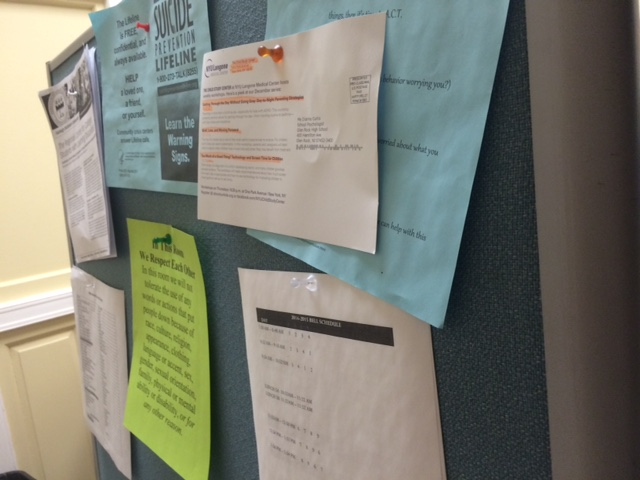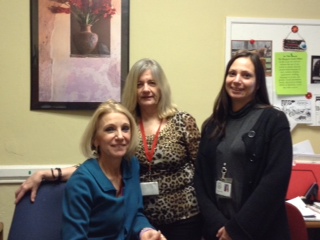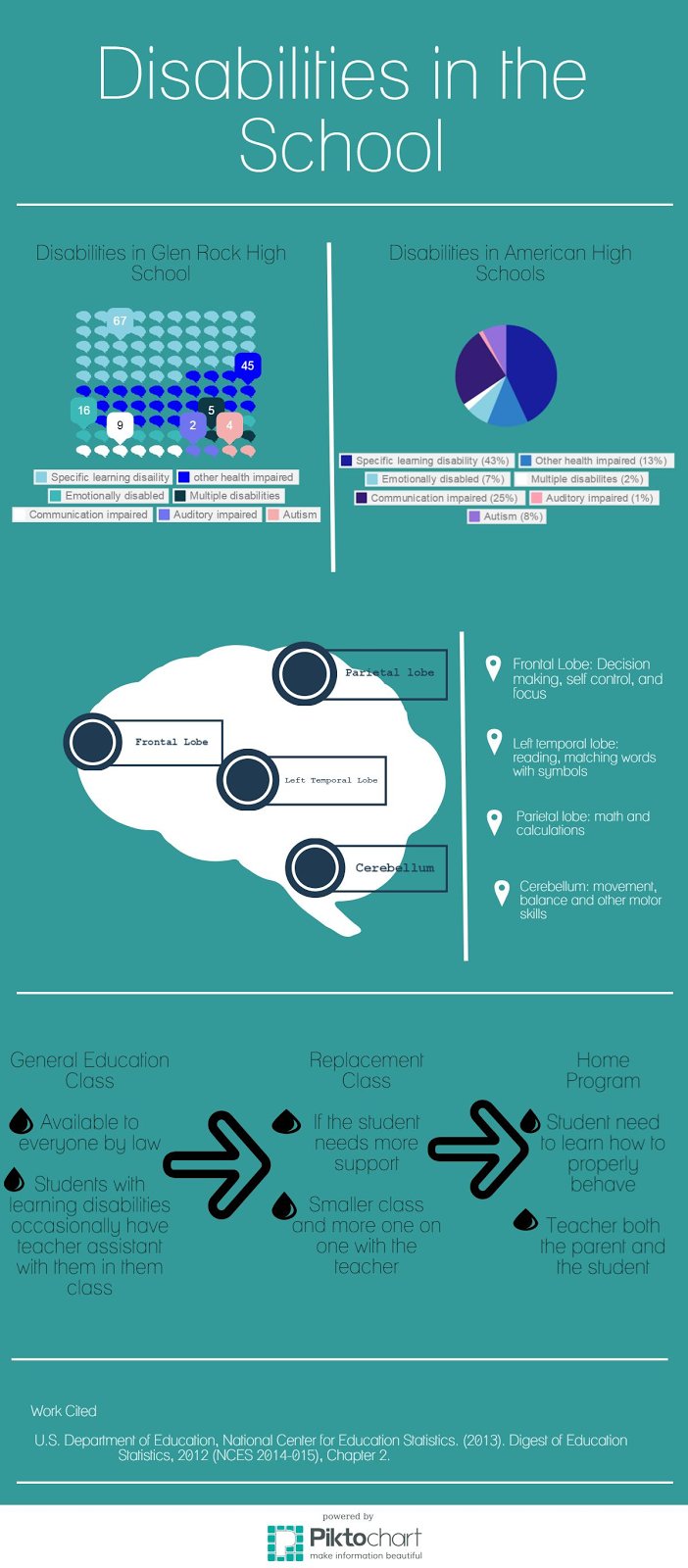An education on Special Education
April 17, 2015
Although their names have been changed, the people whose experiences are depicted in this article are real students from Glen Rock.
Anders has been bullied, but even the bullies don’t understand why.
After school, some students linger at their lockers with their friends while others hurriedly exit the school. The hallway is uncommonly quiet without its usual hustle of students. The harsh light illuminates the hallway as the group of sweat drenched boys, with Anders among them, make their way down to the lobby after a team practice. Exchanging stories of the events that transpired that morning, and occasionally including snide remarks or passive aggressive taunts.
When roaming the halls with his friends Anders is often on the receiving end of these taunts and admits to being called names such as “stupid,” “slow,” or “SPED” — but these words are not the truth. These kind of remarks are made frequently by many of his peers but growing up with it he has grown accustomed to the name calling.
When he was in fifth grade, he was diagnosed with Attention Deficit Disorder (ADD). Children suffering from this condition have trouble maintaining concentration on one particular topic for a prolonged period of time. When he was diagnosed, the teachers placed Anders into a learning strategies classroom so that he could get all the support he needs.

Flyers on support groups and other helpful information hangs on the entryway of the office for students to look for advice
School psychologist and member of the high school Special Education department, Dianne Curtis witnesses bullying for learning disabilities periodically.
“A common assumption about learning disabilities is that people often assume that a student that possesses these disabilities is automatically obtuse or stupid,” Curtis said.
Anders’ peers saw it that way. In the sixth grade, his friends began to think of him as different then them and calling him names because of his extra classes. They did not understand that his condition did not affect his intelligence and continued to pester him with taunts and names.
Anders remembers when one of his friends was having trouble with one of their science projects, they refused Ander’s help insisting “he couldn’t possibly understand” when in fact Anders had gotten a 95% on that very same project.
“Sometimes a student with a disability is more vulnerable than other students may recognize,” Curtis says.
Although generally considered foolish by his peers, Anders maintains a consistent GPA and is currently thriving in his classes. Also, with some extra help after school, he hopes to enter advanced classes the following year.
Students who have been stereotyped are not the only ones with special needs, however.
Sapir is in all of the advanced classes provided for her grade level, maintains a high grade point average, and she excels in her extracurriculars. She admits that people are often surprised to learn that she has dyslexia, a condition that affects a child’s ability to comprehend language, solve simple math problems, distinguish between certain letters, or tell their right from their left.
Luckily, Sapir was diagnosed at an early age, and she only has a mild case of Dyslexia. By working with a tutor, she has been able to overcome obstacles on her way to fulfilling her dream of becoming a marine biologist.
Although the stereotype is that people with disabilities are unintelligent is extant, it is often not the case. People with learning disabilities tend to process information in a unique way that occasionally requires more time.
The Science
A learning disability is a significant discrepancy between a person’s intelligence and what s/he is achieving in some subject area, such as mathematics, reading, writing, or other areas. Although learning disabilities are often referred to in terms such as dyslexia or dysgraphia, Glen Rock High School is trying to minimize the use of the word.
Legally, there are 14 handicapping conditions, some more common in the population than others. Generally, most students fall into the category of having learning disabilities, emotional disturbances, or, occasionally, they fall on the autism spectrum.
The Special Education department oversees 150 students with learning, social, and other disabilities. Yet there are only three staff members on the high school team that share these 150 cases.

The team includes the learning consultant Stephanie Neabore (bottom left), the school psychologist Dianne Curtis (center) and a social worker, Melissa Brinton (far right), who is shared between the middle and high school.
The team includes social worker Melissa Brinton, who works in the middle school as well as the high school; the learning consultant, Stephanie Neabore; and the school psychologist, Dianne Curtis.
Each member of the team has a different number of cases, but the caseload ranges anywhere from 55 to 75 students. The most common condition that students have is a specific learning disability.
On average, one in five American students who is identified as having a learning disability will walk away from his or her education. That 20 percent dropout rate is compared to an 8 percent rate in the general population.
According to an article by Jane Kane, Common misconceptions about learning disabilities, nearly half of the students that are recognized for having a learning disability are three grade levels behind in their academics. “Roughly 2.4 million students — that’s more than the entire population of Houston, Texas — are known to struggle with it,” Kane wrote.
Much research has demonstrated that students with learning disabilities experience emotional distress related to their difficulties. Students that have learning disabilities are more likely to undergo depression, and other
Learning and attention issues among children does not necessarily indicate that a child is lazy or unable to learn. Research shows that certain areas of the brain do not always function properly, which in turn affects a person’s ability to learn or behave in a proper manner.
The frontal lobe of the brain is primarily used for self control, decision-making, emotions and focus. When wired differently it can cause self-control and focus issues because the pathways that carry information are poorly organized and do not signal to other parts of the brain properly. These different wiring are linked to disorders such as attention deficit disorder (ADD).
The left temporal and parietal lobe are located in the back of the brain and helps with reading as well as matching sound with symbols. Some of these areas also help to memorize words. In some kids with dyslexia the two areas are less communicative or underutilized.
The cerebellum helps to direct everyday movements, such as writing and brushing teeth, by controlling movement, posture, and balance. This area of the brain has thought to be connected to other brain functions like emotional processing. However, there are no clear findings.
The final areas of the brain linked with learning disabilities are the parietal lobes at the right and left sides of the brain that involve calculations and mathematics. Some children with dyscalculia or other issues with math these areas of the brain are less active than in other kids.
Implications in the Classroom
In 1974, Glen Rock High School installed ramps and updated its elevator systems to comply with a series of laws passed in New Jersey to ensure that students with disabilities had the same access to the facilities as their peers.
27 years later, in 2001, a female student further changed the structure of the school because of her physical disability. In order to ensure her comfort at the school they added more ramps and changed classrooms to make them more accessible to her and other possible future students.
General education classrooms have become flexible in order to suit the need of students with disabilities. There are now more teacher assistants, different note taking styles and differing methods to show that they have learned the material.
“The teachers here are very good at making modifications for the individual,” Neabore said.
Being observed with other students is dangerous to Anders’ learning because it causes him to fade into the woodwork. The school knows this and therefore provides him with a tutor and extra help after school in the form of support groups.
Often times, students with learning disabilities have their grade weighed differently. They take into account the students’ strengths and weaknesses in order to decided whether homeworks, tests, participation, or projects should be weighed the most in order to determine the student’s grade.

Located in the middle school, the special education office provides a safe and friendly environment for the students
However sometimes it is decided that the student will not be able to function in a general education classroom. In this case the student is placed into a special education classroom which has fewer students. Also, the Special Education classrooms have modifications made to the curriculum to better suit the student. For instance the curriculum may be smaller and will give the really important information rather than specific details about stories or historical events.
There are also other modifications made to tests in order to insure that the student is working to the best of their ability. The teachers often cuts down the test size, or makes it worded specifically for that student in order to see whether or not the student understands the subject.
If a disability is very severe and may distract other students or the teacher, a home program is recommended that helps to teach the parents how to enforce certain behaviors within the student. There have been a severely autistic, or other disabled student at our school that needed to be provided with the home program that was given by Dr. Restivo.
The learning strategies program has been here for more than fifteen years. The Federal Law to first come into existence was in 1975 and was called The Individuals with Disabilities Education Act (IDEA) . However, many school districts were providing services to special needs students well before then. Curtis was first hired in 1977 to work for an agency in Wisconsin that had been providing services for students since the 1950s.
It has evolved and changed in order to conform to the students’ needs. Now the focus in the learning strategies classroom is on a set of skills called Executive Functioning skills. These skills include the mental process that enable us to plan, focus attention, and multitask successfully. These skills need to be taught because students with these conditions need to learn ways that they can manage stress and study normally.
In order to deal with the stress that school provides students often come into the special education office for help and support. The office experiences a heavy flow of students looking for teachers in the department or seeking advice from the school psychologist. The office provides a safe and friendly environment for the students and allows for the team to see the progress the student makes in their school work.
Leaving High School
There is a group of activities that are required for the school to provide the students with towards preparation for college. These programs are very helpful and some specialists recommend them for all students.
Many of these seminars and classes work together with the student in order to dive into career exploration to make certain that the student is going into a field they enjoy and will be able to succeed. The Naviance program is a very useful tool, because it helps to identify the students’ interests and relate them to the electives the students may take.
The programs will occasionally provide opportunities for students with disabilities to gain internships . These internships usually come from the career study that the special education department has access to.
Then for some students who have more severe conditions there is a more intensive program that runs during the summer where students are exposed to employability skills. They learn how to go on an interview for a job, how to seek a job and the program continues in the fall with more career exploration.
During college there are less supports put in place for the student and they have to learn to become more independent. The student must learn to talk to the special education office located at their college in order to gain special tutors as well as extra time for their exams. However the student is expected to show the same work as their peers without disabilities unless they decide to go to a specific college.
Aniella is currently in the process of looking at colleges, however she hopes to become a self-reliant student so that she may prosper in a professional environment and so the colleges may look at her accomplishments rather than her obstacles.
Every high school student with a learning disability has an individualized education program (IEP) provided for them. An IEP is a plan provided by the school to give special accommodations to the students with learning disabilities such as tutors and extra time with teachers. While an extremely helpful service most students hope to grow out of their IEP so they may function in a regular learning environment without help for college.
“I want to get rid of my IEP so that, while I apply for college, the colleges can look beyond my learning disability and see me for the student that I actually am,” Aniella said.
The students are reviewed each year to see whether or not they will be able to leave their IEP and to see what changes can be put in place to better the students education. The school tries to cut back on services so that the student may learn to become more self-reliant. If the Student is in the replacement classes the goal is to try to teach them so that they may learn how to understand the information without the help of the teachers.
“It is a gradual process and takes multiple years, but can be accomplished,” Neabore said.
